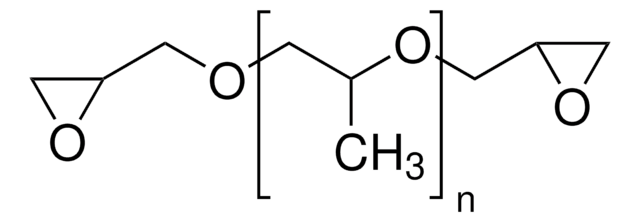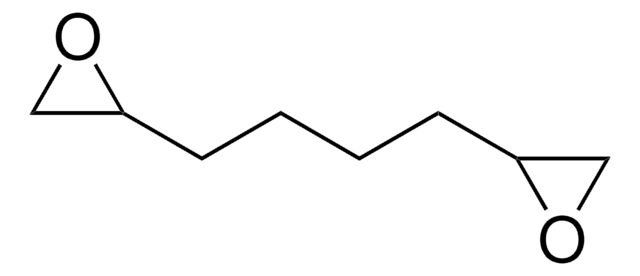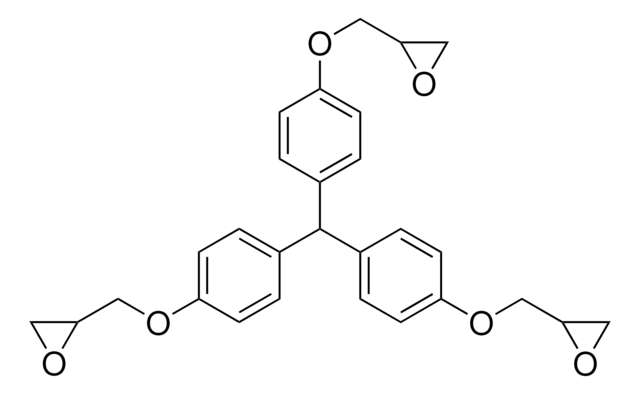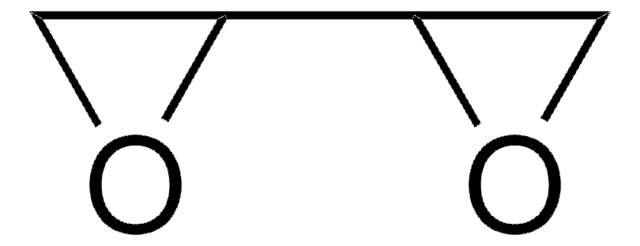338036
Neopentyl glycol diglycidyl ether
technical grade
Sinónimos:
1,3-Bis(2,3-epoxypropoxy)-2,2-dimethylpropane, 2,2′-[(2,2-Dimethyl-1,3-propanediyl)bis(oxymethylene)]bis[oxirane]
About This Item
Productos recomendados
grado
technical grade
Nivel de calidad
densidad de vapor
>1 (vs air)
Formulario
liquid
peso equivalente
135-165 g (epoxide)
índice de refracción
n20/D 1.457 (lit.)
viscosidad
10-30 mPa.s(25 °C)
bp
103-107 °C/1 mmHg (lit.)
densidad
1.04 g/mL at 25 °C (lit.)
cadena SMILES
CC(C)(COCC1CO1)COCC2CO2
InChI
1S/C11H20O4/c1-11(2,7-12-3-9-5-14-9)8-13-4-10-6-15-10/h9-10H,3-8H2,1-2H3
Clave InChI
KUAUJXBLDYVELT-UHFFFAOYSA-N
Categorías relacionadas
Descripción general
Aplicación
- As a cross-linking agent to prepare Pullulan/polydopamine hydrogels for selective adsorption of pollutant cationic dyes.
- As a monomer to synthesize gel polymer electrolytes for Li-ion batteries via cationic ring-open polymerization.
- As a precursor for the synthesis of hybrid epoxy methacrylate resins cationic and free-radical photopolymerization. These epoxy resins can be used as anti-corrosion and decorative coatings.
- To synthesize epoxy nanocomposites for fabrication of light-emitting devices.
Palabra de señalización
Warning
Frases de peligro
Consejos de prudencia
Clasificaciones de peligro
Skin Irrit. 2 - Skin Sens. 1
Código de clase de almacenamiento
10 - Combustible liquids
Clase de riesgo para el agua (WGK)
WGK 1
Punto de inflamabilidad (°F)
235.4 °F - closed cup
Punto de inflamabilidad (°C)
113 °C - closed cup
Equipo de protección personal
Eyeshields, Faceshields, Gloves, type ABEK (EN14387) respirator filter
Elija entre una de las versiones más recientes:
¿Ya tiene este producto?
Encuentre la documentación para los productos que ha comprado recientemente en la Biblioteca de documentos.
Los clientes también vieron
Nuestro equipo de científicos tiene experiencia en todas las áreas de investigación: Ciencias de la vida, Ciencia de los materiales, Síntesis química, Cromatografía, Analítica y muchas otras.
Póngase en contacto con el Servicio técnico









![Bis[4-(glycidyloxy)phenyl]methane mixture of isomers](/deepweb/assets/sigmaaldrich/product/structures/915/436/edb8eab6-834e-4238-a904-bf72c573b686/640/edb8eab6-834e-4238-a904-bf72c573b686.png)
